
Companion-Butterick patterns 6629 and 6623, for teens, twenties, and small women. Woman’s Home Companion, March 1936.
These Spring dresses for “Teens and Twenties” are pretty sophisticated. Either would be a good choice for the office, as well as for the campus. Both have yokes that continue into the sleeves, a modest flare near the hem, and flattering vertical lines in their skirts.
Pattern 6629 has an unusual pointy design in the bodice — I think it’s a terrific look, and would also work with the yoke and sleeves in a lighter color than the body of the dress — a very flattering style if you want your shoulders to look wider and your hips to look narrower.

Companion-Butterick pattern 6629 looks more casual with short sleeves, made in a printed cotton fabric; it looks dressy in a solid material (“blue-green silk crepe”) with longer sleeves. WHC, March 1936.

Look at the interesting backs of 6629 and 6623:

Back views of patterns 6629 and 6623. In these alternate views, the sleeves are wrist length. Dresses like these would usually have a concealed side seam closing under the left arm.

Companion-Butterick pattern 6623, WHC, March 1936, p. 75. another versatile pattern — sporty or business-like. One has a square neckline, the other has a collar and a soft bow.

The “town” version of this pattern is a classic: variations of this dress with a yoke and stitched-down pleats were available in almost every decade that followed. Here’s a 1950’s Vogue pattern with yoke and pleats; Here‘s a 1970’s Chanel; a 1980’s Chanel, a Vogue pattern from the 1980’s, a YSL from the 1990’s….
I’m not absolutely sure what “size 20” translates to in 1936 — probably a 38 inch bust, since many patterns say “sizes 12 to 20; ladies 38 to 44.” Ladies’ sizes were sold by bust measurement and were for women over 5′ 4″ or so — as if women were never both short and in need of a 42″ bust measure….
In 1936, the Butterick sizes that I checked on the CoPA site were:
Size 14: Bust 32″, Waist 27, Hip 35
Size 16: Bust 34″, Waist 28, Hip 37
Size 18: Bust 36″, Waist 30, Hip 39
In addition to these dresses, WHC recommended this town or country suit as the third pattern for a six part wardrobe:

Companion-Butterick pattern 6648, March 1936, was for young women sized 12 to 20. There are town and country versions. Woman’s Home Companion. The suit is navy blue wool with a “yellow chamois” blouse.

The idea behind all three patterns was that, by making two versions of each, you would have a complete wardrobe of casual and dressy outfits. You could even combine the suit jacket with the dresses. And it’s true that making two dresses from the same pattern is a real time-saver. Once you have finished one dress from a pattern, the second version, in different fabric, goes together very quickly.



The dresses have cut on sleeves, don’t they? That would use more fabric, an expensive item for many in the depression era. But I guess they were saving by making the clothes themselves. I love the shoulder detail in 6629. Those points aren’t easy to sew accurately!
Yes — long sleeves of any kind add to the yardage — especially when the fabric is only 39″ wide. I don’t think the little descriptions mentioned whether the fabric estimate was for the long-sleeved versions.
Boy, with the marvel of computers, wouldn’t it be nice if a good pattern company would branch out and do patterns for many body types? Pick a silhouette, give it some dimensions, and a name (Audrey for skinny, say, and Latifah for more generous size, with any number of taller, shorter etc. in between, tho I’m sure the royalties would be horrendous!) with photos and drawings. You could see what looked good on whom and it would help you make any grading decisions of your own. Most of all we could get rid of the assumption that bust and hip are “usually” the same or even in the same ballpark…
Thanks for the wonderful posts. These always make me think if my Mom and Grandma, who made most of their clothes (and quite a few of mine, growing up).
Nancy N
I’m learning that even 1920s patterns assumed the hips were a couple inches bigger than the bust, and Butterick also added a bigger seam allowance there. Maybe we need to rethink fashion illustrations. Or be very skeptical about them.